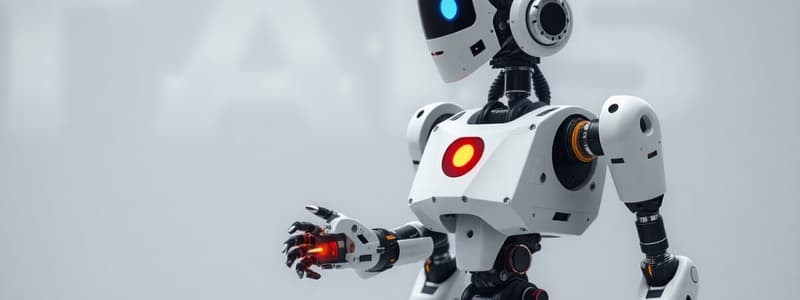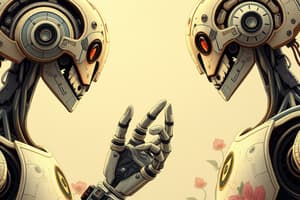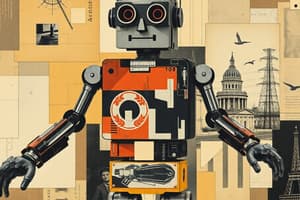Podcast
Questions and Answers
Our robot has 4 drive ______ and 2 color sensors.
Our robot has 4 drive ______ and 2 color sensors.
motors
We recreated our robot ______ times to improve its design.
We recreated our robot ______ times to improve its design.
3
One ______ is to use the same attachment and program more than once.
One ______ is to use the same attachment and program more than once.
strategy
Our robot has new ______ this year, adapted from the research of other teams.
Our robot has new ______ this year, adapted from the research of other teams.
We learned to use 'my ______' to make coding for turns easier.
We learned to use 'my ______' to make coding for turns easier.
Programming was a ______ part of our robot game.
Programming was a ______ part of our robot game.
We used a portable ______ this year for programming.
We used a portable ______ this year for programming.
When we worked together and pooled our ______, we accomplished our tasks more efficiently.
When we worked together and pooled our ______, we accomplished our tasks more efficiently.
Flashcards
Robot Components
Robot Components
The robot has four motors that power the wheels and two color sensors that allow it to detect different colors.
Reusing Program and Attachment
Reusing Program and Attachment
The team reused the same attachment and program multiple times to complete different missions, maximizing efficiency.
Iterative Design Process
Iterative Design Process
The team's robot was redesigned and improved multiple times throughout the season, learning from previous iterations and research.
Collaborative Design
Collaborative Design
Signup and view all the flashcards
Optimized Robot Design
Optimized Robot Design
Signup and view all the flashcards
Coding with My Blocks
Coding with My Blocks
Signup and view all the flashcards
Program Testing and Optimization
Program Testing and Optimization
Signup and view all the flashcards
Programming Importance
Programming Importance
Signup and view all the flashcards
Study Notes
Robot Design and Strategy
-
Robot Specifications:
- Four drive motors
- Two color sensors
- Rubber wheels with a near-flat surface for good traction
- Two attachments
-
Design Process:
- Iterative redesign: The team recreated the robot three times, improving design each iteration.
- Initial robot issues: First robot was too large; second wasn't strong enough.
- Gear research: Learning and applying gear knowledge from resources.
- Collaboration: At least three people worked actively on each attachment design.
Mission Strategy
- Single-mission focus: Primarily focusing on single missions initially due to limited experience.
- Repeated attachment use: Using the same attachment and program multiple times when possible, for efficiency.
Innovation and Challenges
- New features: Utilizing research and success from other teams for their robot features.
- Motor power increase: Adjustment in motor power for mission completion.
- Programming advancement: Using "my blocks" for more precise turn control, important for all missions.
- Programming Testing: Continued testing and adjustments throughout the season for accurate programs.
- Portable laptop: Use of a portable laptop for flexibility and last-minute program changes.
Mechanical Design
- Compact design: Robot design is efficient and not excessively large.
- Attachment conservation: Reusing attachments for maximum missions, reducing unnecessary removal.
Programming
- Crucial role: Programming was significant to the robot's success.
- Accurate programs: Programs were refined and tested throughout the season.
- Adaptable programming setup: Utilizing a portable laptop for agile programming adjustments.
Team Dynamics and Enjoyment
- Cooperative work: Teamwork and knowledge sharing accelerated progress and project completion.
- Efficient meetings: Combined knowledge and focused work streamlined team meetings, increasing enjoyment.
- Programming enjoyment: Team members found programming rewarding as skill developed.
Studying That Suits You
Use AI to generate personalized quizzes and flashcards to suit your learning preferences.





